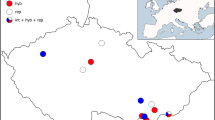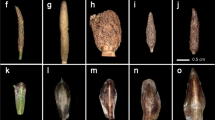Abstract
The tetraploidAllium altyncolicum (2n = 4x = 32) is considered to be of hybrid origin, because most of its morphological characters are intermediate between those of its putative parents,A. schoenoprasum andA. ledebourianum. In the present work an attempt has been made to ascertain its parentage by several methods: Giemsa C-banding, genomic in situ hybridization (GISH), PCR-RFLP of cpDNA, restriction enzyme mapping of the rDNA, and RAPDs. C-banding and GISH indicates clearly thatA. altyncolicum is a segmental allopolyploid.Allium schoenoprasum andA. ledebourianum are the most likely the parental species and the larger part of the genome ofA. altyncolicum (26 chromosomes) is derived fromA. schoenoprasum. The low genetic divergence between these three species was confirmed by the lack of sequence variation in the ITS sequences of nuclear rRNA genes and of the plastid rbcL-atpB intergenic spacer. Both parental species andA. altyncolicum could be distinguished by RFLP of the rDNA repeats. The geographic origin of the putative parental species was investigated using RAPDs.
Similar content being viewed by others
References
Adaniya, S., Fujieda, K., Matsu, E., Ogawa, T., 1978: Karyotypes and origin ofAllium wakegi. — Chromosome Inform. Serv.24: 16–18.
Agapova, N. D., Archarova, K. B., Vachtina, L. I., Zemskova, E. A., Tarvis, L. V., 1990: Chromosome numbers of flowering plants USSR:Aceraceae —Menyanthaceae. — Leningrad: Nauka. (In Russian.)
Allard, R. W., Garcia, P., Saenz-de-Miera, L. E., Perez de la Vega, M., 1993: Evolution of multilocus genetic structure inAvena hirtula andAvena barbata. — Genetics135: 1125–1139.
Anamthawat-Jonsson, K., Schwarzacher, T., Leitch, A. R., Bennett, M. D., Heslop-Harrison, J. S., 1990: Discrimination between closely relatedTriticeae species using genomic DNA as a probe. — Theor. Appl. Genet.79: 721–728.
—, 1996: Genomic in situ hybridization for whole chromosome and genome analysis. — InClark, M., (Ed.): In situ hybridization. Laboratory companion, pp. 1–23. — Weinheim: Chapman & Hall.
Bailey, J. P., Bennett, S. T., Bennett, M. D., Stace, C. A., 1993: Genomic in situ hybridization identifies parental chromosomes in the wild grass hybrid ×Festulpia hubbardii. — Heredity71: 413–420.
Bennett, S. T., Kenton, A. Y., Bennett, M. D., 1992: Genomic in situ hybridization reveals the allopolyploid nature ofMilium montianum (Gramineae). — Chromosoma101: 420–424.
Borisjuk, N., Hemleben, V., 1993: Nucleotide sequence of the potato rDNA intergenic spacer. — Pl. Molec. Biol.21: 381–384.
—, 1989: Ribosomal RNA gene organization in higher plant fromNicotiana genus. — Molec. Biol. (Russia)23: 1067–1074.
—, 1989: Organization of ribosomal RNA genes inBrassica oleracea, Brassica campestris and their natural allotetraploid hybridBrassica napus. — Genetica25: 417–424.
—, 1994: Comparison of nuclear ribosomal RNA genes amongSolanum species and otherSolanaceae. — Genome37: 271–279.
Cai, Q., Chinnappa, C. C., 1987: Giemsa C-banded karyotypes of seven North American species ofAllium. — Amer. J. Bot.74: 1087–1092.
Demesure, B., Sodzi, N., Petit, R. J., 1995: A set of universal primers for amplification of polymorphic non-coding regions of mitochondrial and chloroplast DNA in plants. — Molec. Ecol.4: 129–131.
Ehrendorfer, F., 1980: Polyploidy and distribution. — InLewis, W., (Ed.): Polyploidy: biological relevance, pp. 45–66. — New York: Plenum Press.
Fiskesjö, G., 1975: Chromosomal relationships between three species ofAllium as revealed by C-banding. — Hereditas81: 23–32.
Friesen, N., 1985: Chromosome numbers in the representatives of the familyAlliaceae from the Siberia. — Bot. J. Leningrad70: 1001–1002. (In Russian.)
—, 1987: A new species of the genusAllium (Alliaceae) from the Altai. — Bot. Zhurn. (Moscow & Leningrad)72: 815–820. (In Russian.)
—, 1988:Alliaceae of Siberia: systematics, karyology, chorology. — Novosibirsk: Nauka, Sibir. Otdel. (In Russian.)
—, 1996: A taxonomic and chorological revision of the genusAllium L. sect.Schoenoprasum Dumort. — Candollea51: 461–473.
Fuchs, J., Brandes, A., Schubert, I., 1995: Telomere sequence localisation and karyotype evolution in higher plants. — Pl. Syst. Evol.196: 227–241.
Grant, V., 1981: Plant speciation. — New York: Columbia University Press.
Greilhuber, J., 1984: Chromosomal evidence in taxonomy. — InHeywood, V. H., Moore, D. M., (Eds): Current concepts in plant taxonomy. — Syst. Ass. Spec. Vol.25: 157–180. — London, Orlando: Academic Press.
—, 1976: C-banded karyotypes in theScilla hohenackeri group,S. persica, andPuschkinia (Liliaceae). — Pl. Syst. Evol.126: 149–188.
—, 1978: Quantitative analyses of C-banded karyotypes, and systematics in the cultivated species of theScilla siberica group (Liliaceae). — Pl. Syst. Evol.129: 63–109.
Gründler, P., Unfried, I., Pascher, K., Schweizer, D., 1991: rDNA intergenic region fromArabidopsis thaliana. Structural analysis, intraspecific variation and functional implications. — J. Molec. Biol.221: 1209–1222.
Havey, M. J., 1992: Restriction enzyme analysis of the nuclear 45S ribosomal DNA of six cultivated Alliums (Alliaceae). — Pl. Syst. Evol.181: 45–55.
Hemleben, V., Ganal, M., Gerstner, J., Schiebel, K., Torres, R. A., 1988: Organization and length heterogeneity of plant ribosomal RNA genes. — InKahl, G., (Ed.): The architecture of eukaryotic genes, pp. 371–384. — Weinheim: VHC.
Heslop-Harrison, J. S., Schwarzacher, T., Leitch, A. R., Anamthawat-Jónsson, K., Bennett, M. D., 1988: A method of identifying DNA sequences in chromosomes of plants. — European Patent Application Number 8828130.8.
—, 1990: Detection and characterization of 1B/1R translocation in hexaploid wheat. — Heredity65: 356–362.
Hizume, M., 1994: Allodiploid nature ofAllium wakegi Araki revealed by genomic in situ hybridization and localization of 5S and 18S rDNAs. — Japan. J. Genet.69: 407–415.
Keller, E. R. J., Schubert, I., Fuchs, J., Meister, A., 1996: Interspecific crosses of onion with distantAllium species and characterization of the presumed hybrids by means of flow cytometry, karyotype analysis and genomic in situ hybridization. — Theor. Appl. Genet.92: 417–424.
Kenton, A., 1978: Giemsa C-banding inGibasis (Commelinaceae). — Chromosoma65: 309–324.
Krylov, P., 1912: Flora of Altai and Tomsk Gubernia.6, pp. 1251–1534. — Tomsk. (In Russian.)
Leitch, A. R., Schwarzacher, T., Mosgoller, W., Bennett, M. D., Heslop-Harrison, J. S., 1991: Parental genomes are separated throughout the cell cycle in a plant hybrid. — Chromosoma101: 206–213.
—, 1994: In situ hybridization: a practical guide. — Oxford: BIOS Scientific Publishers.
Levan, A., 1936: Zytologische Studien anAllium schoenoprasum. — Hereditas22: 1–128.
Maaß, H. I., Klaas, M., 1995: Infraspecific differentiation of garlic (Allium sativum L.) by isozyme and RAPD markers. — Theor. Appl. Genet.91: 87–97.
Mc Mullen, M. D., Hunter, D. B., Phillips, R. L., Rubenstein, I., 1986: The structure of the maize ribosomal DNA spacer region. — Nucl. Acids Res.14: 4953–4968.
Maggini, F., Garbari, F., 1977: Amount of ribosomal DNA inAllium (Liliaceae). — Pl. Syst. Evol.128: 201–208.
Mes, T. H. M., Friesen, N., Fritsch, R. M., Klaas, M., Bachmann, K., 1997: Criteria for sampling inAllium based on chloroplast DNA PCR-RFLPs. — Syst. Bot. (in press).
Mukai, Y., Gill, B. S., 1991: Detection of barley chromatin added to wheat by genomic in situ hybridization. — Genome34: 448–452.
—, 1993: Sumultaneous discrimination of the three genomes in hexaploid wheat by multicolor fluorescence in situ hybridization using total genomic and hyghly repeated DNA probes. — Genome36: 489–494.
Parokonny, A. S., Kenton, A. Y., Meredith, L., Owens, S. J., Bennett, M. D., 1992: Genomic divergence of allopatric sibling species studied by molecular cytogenetics of their F1 hybrids. — Pl. J.2: 695–704.
Puizina, J., Papes, D., 1996: Cytogenetical evidences for hybrid structure and origin of diploid and triploid shallots (Allium cepa var.viviparum, liliaceae) from Dalmatia (Croatia). — Pl. Syst. Evol.199: 203–215.
Rieseberg, L. H., 1996: Homology among RAPD fragments in interspecific comparisons. — Molec. Ecol.5: 99–105.
Saghai-Maroof, M. A., Soliman, K. M., Jorgensen, R. A., Allard, R. W., 1984: Ribosomal DNA spacer-length polymorphisms in barley: Mendelian inheritance, chromosomal location, and population dynamics. — Proc. Natl. Acad. Sci. USA81: 8014–8018.
Sambrook, J., Fritsch, E. F., Maniatis, T., 1989: Molecular cloning: a laboratory manual. — Cold Spring Harbor, N.Y.: Cold Spring Habor Laboratory Press.
Schubert, I., Ohle, H., Hanelt, P., 1983: Phytogenetic conclusions from Giemsa banding and NOR staining in top onions (Liliaceae). — Pl. Syst. Evol.143: 245–256.
—, 1985: In situ hybridization confirms jumping nucleolus organizing region inAllium. — Chromosoma92: 143–148.
Schwarzacher, T., Leitch, A. R., Bennett, M. D., Heslop-Harrison, J. S., 1989: In situ localization of parental genomes in a wide hybrid. — Ann. Bot.64: 315–324.
—, 1980: Application of Giemsa banding to orchid karyotype analysis. — Pl. Syst. Evol.134: 293–297.
Schwarzacher, T., Heslop-Harrison, J. S., Anamthawat-Jónsson, K., Finch, R. A., Bennett, M. D., 1992: Parental genome separation in reconstructions of somatic and premeiotic metaphases ofHordeum vulgare ×H. bulbosum. — J. Cell Sci.101: 13–24.
Stearn, W. T., 1980:Allium L. — InTutin, T. G., Heywood, V. H., Burges, N. A., Moore, D. M., Valentine, D. H., Walters, S. M., Webb, D. A., (Eds): Flora Europaea,5, pp. 49–69. — Cambridge: Cambridge University Press.
Tal, M. M., 1980: Physiology of polyploids. — InLewis, W., (Ed.): Polyploidy: biological relevance, pp. 61–75. — New York: Plenum Press.
Tatlioglu, T., 1993: ChiveAllium schoenoprasum L. — InKalloo, G., Bergh, B. O., (Eds): Genetic improvement of vegetable crops, pp. 3–13. — Oxford: Pergamon Press.
Tardif, B., Morisset, P., 1991: Chromosomal C-band variation inAllium schoenoprasum (Liliaceae) in eastern North America. — Pl. Syst. Evol.174: 125–137.
Tsumura, Y., Yoshimura, K., Tomaru, N., Ohba, K., 1995: Molecular phylogeny of conifers using RFLP analysis of PCR-amplified specific chloroplast genes. — Theor. Appl. Genet.91: 1222–1236.
Turesson, G., 1931: Über verschiedene Chromosomenzahlen inAllium schoenoprasum L. — Bot. Not.86: 15–20.
—, 1966: Genecological notes onAllium schoenoprasum L. — Trans. & Proc. Bot. Soc. Edinburgh40: 181–184.
Vosa, C. G., 1973: Heterochromatin recognition and analysis of chromosome variation inScilla siberica. — Chromosoma43: 269–278.
—, 1976: Heterochromatic patterns inAllium I. The relationship between the species of thecepa group and its allies. — Heredity36: 383–392.
White, T. J., Bruns, T., Lee, S., Taylor, J., 1990: Amplification and direct sequencing of fungal ribosomal RNA genes for phylogenetics. — InInnis, M. A., Gelfand, D. H., Sninsky, J. J., White, T. J., (Eds): PCR-protocols, a guide to methods and applications, pp. 315–322. — London, New York: Academic Press.
Author information
Authors and Affiliations
Additional information
Dedicated to emer. Univ.-Prof. DrFriedrich Ehrendorfer on the occasion of his 70th birthday
Rights and permissions
About this article
Cite this article
Friesen, N., Borisjuk, N., Mes, T.H.M. et al. Allotetraploid origin ofAllium altyncolicum (Alliaceae, Allium sect.Schoenoprasum) as investigated by karyological and molecular markers. Pl Syst Evol 206, 317–335 (1997). https://doi.org/10.1007/BF00987955
Received:
Revised:
Accepted:
Issue Date:
DOI: https://doi.org/10.1007/BF00987955




